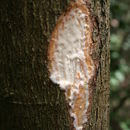Comprehensive Description
provided by Smithsonian Contributions to Botany
Chlorophora excelsa (Welwitsch) Bentham & J.D. Hooker
Standard trade name: Iroko
Local names: Odura (Ghana), Iroko (Nigeria), Kambala (French-speaking West Africa)
A large tree of deciduous and evergreen forests reaching 160 ft and up to 30 ft in girth. Unbut-tressed and unbranched for 80 ft. The bark is smooth but becomes brown and scaly. The leaves of young trees of both sexes are 9 × 4 in, acuminate and serrulate; on the mature tree they are entire. The trees are dioecious; female flowers are on compact spikes 2 in long, male flowers are in dense spikes reaching 8 in long.
GENERAL DESCRIPTION.—Sapwood, pale in color, is clearly distinguishable from the pale yellowish brown or dark chocolate-brown heartwood. It is a medium weight, averaging about 40 lb/ft3 seasoned and about 65 lb/ft 3 green. The grain is typically interlocked. The texture is coarse.
SEASONING.—Iroko seasons well without much degrade. The British Forest Products Laboratory kiln schedule E has proved satisfactory (FPRL, 1956).
DURABILITY.—Very durable. The timber is resistant to, but not immune from, termite attack. It is extremely resistant to preservative treatment. The sapwood is permeable.
WORKING QUALITIES.—Iroko is hard to work with hand and machine tools, and dulls cutting edges very rapidly. Due to its interlocked grain, care must be taken in planing quarter-sawn material to avoid pick-up; a reduction of cutting angle to about 15D may be necessary. It takes nails and screws well, stains and polishes well, although it requires grain filler. It glues satisfactorily.
USES.—It is extensively used locally for all kinds of construction work and carpentry. It is used for railroad cross-ties, bridges, fencing, carriage and wagon construction, and for bearers and flooring. Iroko is also used for tight cooperage and also for containers for radioactive materials.
XYLEM ANATOMY.—Growth rings present. Wood diffuse-porous. Vessels: solitary or in pairs, rarely 3’s; circular to oval in cross-section; average pore diameter 260μm, range 100μm–390μm; average vessel element length 430μm, range 250μm–625μm; vessel wall thickness 4μm–6μm; perforation plates probably simple; vessel element end wall inclination is transverse; intervascular pitting transitional, between alternate and opposite, slitlike and small. Imperforate tracheary elements: nonseptate fiber tracheids, average length 1780μm, range 1563μm–2275μm; simple pits few on the radial walls. Vascular rays: heterocellular (upright and procumbent cells—the upright cells confined to the top and bottom of the ray), multiseriate, mostly 3 or 4 cells wide, 10 to 25 cells high, biseriate rays rare, uniseriate absent. Rays almost storied (transitional). Axial parenchyma: paratracheal, aliform confluent. Crystals: none observed, although generally noted for its profuse crystals of calcium oxalate, which sometimes coagulate to form big lumps. Special note: Tyloses present in vessels.
Using Tippo’s 1946 concept of phytogeny, with special reference to xylem anatomy, this wood appears to be generally more advanced due to the simple transverse perforation plate, shorter circular vessels, transitional pitting of vessel wall between opposite and alternate types, paratracheal axial parenchyma and the almost storied nature of the rays and fibers.
- bibliographic citation
- Ayensu, Edward S. and Bentum, Albert. 1974. "Commercial Timbers of West Africa." Smithsonian Contributions to Botany. 1-69. https://doi.org/10.5479/si.0081024X.14

